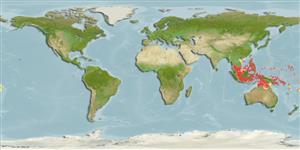>
Syngnathiformes (Pipefishes and seahorses) >
Syngnathidae (Pipefishes and seahorses) > Syngnathinae
Etymology: Hippocampus: Greek, ippos = horse + Greek,kampe = curvature (Ref. 45335); denise: Named after Denise Tackett; noun in apposition.
Eponymy: Denise Tackett née Nielsen (1947–2015) was a well-respected American writer and photographer of marine life in general and reef life in particular. [...] (Ref. 128868), visit book page.
More on authors: Lourie & Randall.
Environment: milieu / climate zone / depth range / distribution range
Ecologia
marinhas associadas(os) a recifes; não migratória; intervalo de profundidade 7 - 100 m (Ref. 128812). Tropical
Indo-West Pacific: Indonesia to Vanuatu; north to the Philippines, south to northeast Australia.
Length at first maturity / Tamanho / Peso / Idade
Maturity: Lm 1.1 range ? - ? cm
Max length : 2.2 cm SL macho/indeterminado; (Ref. 47053); 2.4 cm SL (female)
Descrição breve
Chaves de identificação | Morfologia | Morfometria
Raios dorsais moles (total) : 14. Color in life plain orange with slightly darker rings around tail; when preserved, pale orange with tiny dark brown flecks on the nape of the neck and all over in some specimens. Diminutive in size. Anal fin small or absent. Rings on trunk 12; on tail 28-29. Body fleshy with inferior and ventral trunk ridges reduced to separated cross-shaped spicules embedded in the skin. Nuchal plate rounded without a raised coronet. Snout length ca. 30% in HL. Head depth ca. 50% in HL. No spines above the eye. Trunk depth (between the 9th and 10th trunk rings) ca. 7% in SL (female) and 10-15% in SL (male). The angles of certain body ridges sometimes developed into rounded tubercles (distinctly fewer and less developed compared with H. bargibanti) (Ref. 47053).
Lives in association with gorgonian seafans (Annella reticulata, Muricella sp., and Echinogorgia sp.). Master of camouflage, with their coloration and body ornamentation in the form of tubercles, can match the stems and polyps of their gorgonian hosts (Ref. 47053). Ovoviviparous (Ref. 205). The male carries the eggs in a brood pouch which is found under the tail (Ref. 205).
Life cycle and mating behavior
Maturidade | Reprodução | Desova | Ovos | Fecundidade | Larvas
Male carries the eggs in a brood pouch (Ref. 205).
Lourie, S.A., R.A. Pollom and S.J. Foster, 2016. A global revision of the seahorses Hippocampus Rafinesque 1810 (Actinopterygii: Syngnathiformes): taxonomy and biogeography with recommendations for further research. Zootaxa 4146(1):1-66. (Ref. 115213)
Categoria na Lista Vermelha da IUCN (Ref. 130435: Version 2024-2)
Ameaça para o homem
Harmless
Utilização humana
Ferramentas
Relatórios especiais
Descarregue XML
Fontes da internet
Estimates based on models
Preferred temperature (Ref.
123201): 26.2 - 28.5, mean 27.4 °C (based on 157 cells).
Phylogenetic diversity index (Ref.
82804): PD
50 = 0.5000 [Uniqueness, from 0.5 = low to 2.0 = high].
Bayesian length-weight: a=0.00447 (0.00175 - 0.01142), b=2.99 (2.77 - 3.21), in cm total length, based on LWR estimates for this (Sub)family-body shape (Ref.
93245).
Nível Trófico (Ref.
69278): 3.1 ±0.5 se; based on size and trophs of closest relatives
Resiliência (Ref.
120179): Elevada, tempo mínimo de duplicação da população menor que 15 meses (Preliminary K or Fecundity.).
Fishing Vulnerability (Ref.
59153): Low vulnerability (10 of 100).
Nutrients (Ref.
124155): Calcium = 708 [204, 5,752] mg/100g; Iron = 4.3 [1.0, 13.3] mg/100g; Protein = 17.2 [14.7, 19.6] %; Omega3 = 0.136 [0.018, 1.115] g/100g; Selenium = 154 [15, 1,179] μg/100g; VitaminA = 23.6 [1.4, 351.3] μg/100g; Zinc = 9.45 [3.10, 22.63] mg/100g (wet weight);
